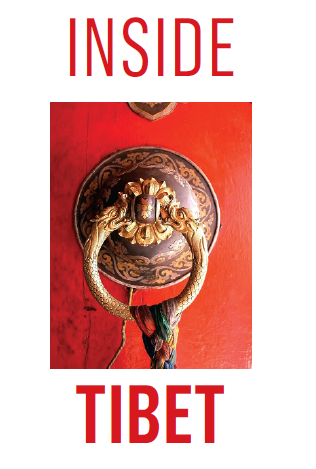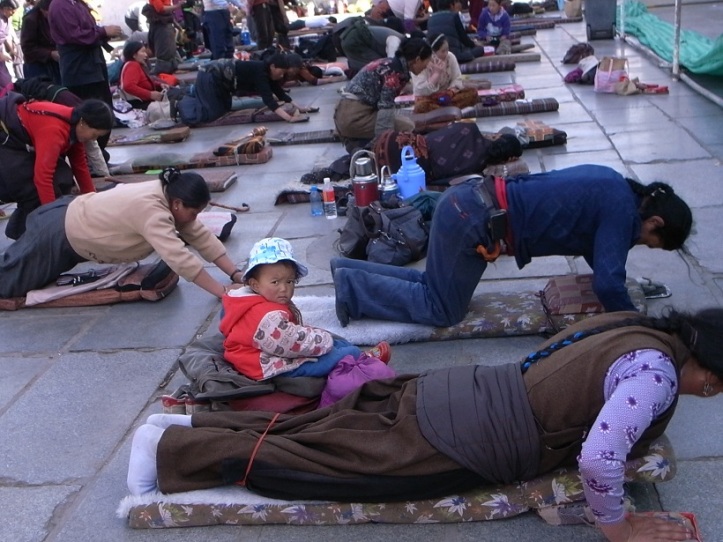
Third in a series
Once a nation’s capital, Tibet’s first city now teems with Chinese entrepreneurs, right down to its Old Quarter roots

Manote Tripathi
The Nation
Lhasa
The Lhasa railway station is 3,490 metres up in the air – or, at least, above sea level. In just 24 hours the train has climbed from 2,275 metres in Xining to 5,072 at the Tanggula Pass, before coasting more or less downward into Lhasa.
It’s been a dizzying experience, and Lhasa somehow feels like solid ground.
“I can’t believe I’ve made it!” exults Anna, a German I’d met at my hotel in Xining and again on the train. We kiss the ground at the station, which is modelled after the iconic Potala Palace, and giggle at our good fortune.
Anna is set for a 28-day tour of the region, just her and a guide, including a trip to Mount Kailash.
I’d ridden to Tibet astride a famous piece of advice from the 14th Dalai Lama – whose portrait is nowhere to be seen in Lhasa, by the way. “Go to Tibet,” he said, “and see many places, as much as possible, then tell the world.”
My own guide is waiting with his Landcruiser 4500 to take me to a hotel in the Old Quarter. No foreign tourists are allowed to roam on their own. He’s my insurance against trouble with the authorities.
At the hotel I meet Jane, a Dane, and Mike, a New Zealander, with whom I’d made online arrangements for a two-week joint tour. Visitors commonly form groups to split the costs.
Jane is a biologist who was taking her PhD at the University of California in LA when she asked a guy from the computer lab to fix her laptop.
That turned out to be Mike, a bit of a computer geek (he can access Facebook in China despite the website’s ban) but would soon be doing marine research in the North Sea for a Danish firm.
Mike and Jane hit it off and eventually set up house together in Copenhagen.
In Lhasa the three of stay at a family-run guesthouse in the Old Quarter, which is known as the “most Tibetan” area of the former national capital, now regional capital.
Travellers usually stay in Lhasa for three days to get used to the climate and altitude before venturing outside the city. It gives is a chance to look around and get to know each other, and, in fact, none of us would experience any illness due to the heights.
Lhasa in late winter is sunny and a warm-ish 13 degrees during the day, but very cold at night.
In planning our trip we decide to stick with hotels run by Tibetans – we want to support the locals, not the Chinese “colonists” who are flooding the region.
For “real” Tibetan atmosphere, the Old Quarter is best, though it’s tiny on the city map. There’s a pilgrimage trail that circles the Jokhang Monastery, along which many elderly people trek from dawn to dusk, mostly hunched-over women with prayer wheels in hand.
The Old Quarter is still patrolled day and night by Chinese security men armed with assault rifles, an obvious result of the Tibetan uprising in 2008, during which the incensed locals set Chinese shops ablaze.
Beijing accused the Dalai Lama, Tibet’s exiled spiritual leader, of masterminding the unrest to push for independence – and spoil the Beijing Olympics. The Dalai Lama scoffed at the charges and continues to insist he wants only autonomy, not independence, for Tibet.
But Lhasa today is one of China’s great boomtowns, thriving on the new railway line. Four million tourists come every year for the picturesque temples and Tibetan culture, as well as the mountain scenery.
My travelling companions and I reckon that fast-changing Lhasa looks just like any other Chinese city, its streets lined not with trees but Chinese shops, supermarkets, restaurants, hotels, advertising billboards and the ubiquitous spaghetti-like tangles of sagging power lines.
Even in the Old Quarter, new hotels and restaurants are springing up close to the venerated Jokhang Monastery, but the beggars on the curbs are all Tibetans, including nuns and monks.
The Chinese – primarily Han – are migrating here in large numbers. Their language predominates in the signs on restaurants and the shops of cobblers and tailors, and even the placards brandished by the sex workers and beggars who’ve arrived to ply their trades.
They’re lured by the lucre generated by large government subsidies plied on the region since the mid-1990s, particularly for the Western Development Drive that began in 2000.
Carpenters in Qinghai were earning 15 yuan (Bt70) a day, but a job helping build the railway to Lhasa was worth 50 yuan per day. The Han easily out-compete the Tibetans because they speak Mandarin and know how decisions are made in the system.
The Chinese gains have pushed Tibetans out of the sectors enjoying the most dynamic economic growth, like government administration and large-scale construction.
After a stroll along Beijing Street I arrive back at Barkhor Square, in front of the Jokhang Monastery, still exerting its mysterious gravitational pull on a stream of pilgrims.
This is the modern path for the pilgrims. The older Tibetans with ponytails do as they’ve always done – amble along, tirelessly chanting “Ohm mani padme hum” and spinning prayer wheels.
Their rhythmic sounds, though, are now joined by the raucous shouts of Chinese vendors wielding mobile phones, announcing discounts, while Chinese soldiers with machine guns keep watch.
The view of Lhasa on my first day can’t be any more of a contrast.
Next Monday: How Lhasa’s past explains its present.